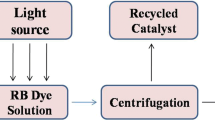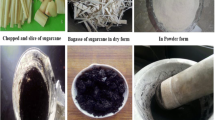Abstract
In this research work, tungsten trioxide (WO3) and activated doped WO3 composites were prepared for the photocatalytic degradation of rhodamine-B. Activated carbon was prepared by waste sugarcane burgesses, tungsten trioxide (WO3) was synthesized by precursor sodium tungstate dihydrate (Na2WO4·2H2O) using hydrothermal method. To study the morphology, functional groups, band gap, purity and optical properties of the prepared catalyst SEM, FTIR, PL and UV–Vis spectroscopy were used. SEM micrograph shows that tungsten trioxide has nanocubic rods-like structure with size 50–500 nm. Morphological results showed that nano rods become sharper when activated carbon were added in WO3. The average nanorods have average size 20–250 nm which is very efficient for degradation. UV–Vis spectroscopy shows that band gap of the fabricated catalyst changes from 2.76 to 2.26 eV by varying the concentration ratio of the activated carbon. FTIR analysis the functional groups of the prepared catalyst. PL-spectroscopy determined that the maximum excitation wavelength was 446 nm. Photocatalytic results show that 2% activated carbon doped WO3 composite shows the maximum degradation rate as compare to the other prepared catalyst. Synthesized catalysts are environment friendly, cost effective and due to low band gap very useful for the degradation purpose.














Similar content being viewed by others
References
Abazari R et al (2014) Characterization and optical properties of spherical WO3 nanoparticles synthesized via the reverse microemulsion process and their photocatalytic behavior. Mater Lett 133:208–211
Adhikari S, Sarkar D, Maiti HS (2014) Synthesis and characterization of WO3 spherical nanoparticles and nanorods. Mater Res Bull 49:325–330
Alaei M, Mahjoub AR, Rashidi A (2012) Effect of WO3 nanoparticles on congo red and rhodamine B photo degradation. Iran J Chem Chem Eng (IJCCE) 31(1):23–29
Amin NK (2008) Removal of reactive dye from aqueous solutions by adsorption onto activated carbons prepared from sugarcane bagasse pith. Desalination 223(1–3):152–161
Andreozzi R et al (1999) Advanced oxidation processes (AOP) for water purification and recovery. Catal Today 53(1):51–59
Anfar Z et al (2018) Well-designed WO3/activated carbon composite for rhodamine B removal: synthesis, characterization, and modeling using response surface methodology. Fuller Nanotubes Carbon Nanostruct 26(6):389–397
Cai L et al (2015) Highly effective and stable Ag3PO4–WO3/MWCNTs photocatalysts for simultaneous Cr(VI) reduction and orange II degradation under visible light irradiation. Appl Surf Sci 353:939–948
Cao J et al (2011) Photocatalytic activity of novel AgBr/WO3 composite photocatalyst under visible light irradiation for methyl orange degradation. J Hazard Mater 190(1–3):700–706
Chaudhary A et al (2017) TiO2, WO3, and V2O5, supported on activated carbon: preparation, structural and catalytic behaviour in photocatalytic treatment of phenol and lignin from olive mill wastewater. Fresenius Environ Bull 26(5):3529–3541
Ding J et al (2017) Synergistic effects of electronic structure of WO3 nanorods with the dominant 001 exposed facets combined with silver size-dependent on the visible-light photocatalytic activity. Appl Catal B 203:335–342
El-Salamony RA et al (2018) Visible light sensitive activated carbon-metal oxide (TiO2, WO3, NiO, and SnO) nano-catalysts for photo-degradation of methylene blue: a comparative study. Toxicol Environ Chem 100(2):143–156
Esplugas S et al (2002) Comparison of different advanced oxidation processes for phenol degradation. Water Res 36(4):1034–1042
Gan L et al (2016) Visible light induced methylene blue dye degradation photo-catalyzed by WO3/graphene nanocomposites and the mechanism. Ceram Int 42(14):15235–15241
He Z et al (2009) Photocatalytic degradation of rhodamine B by Bi2WO6 with electron accepting agent under microwave irradiation: mechanism and pathway. J Hazard Mater 162(2–3):1477–1486
Helfrich A, Brüchert W, Bettmer J (2006) Size characterisation of Au nanoparticles by ICP–MS coupling techniques. J Anal Atom Spectrom 21(4):431–434
Hepel M, Hazelton S (2005) Photoelectrocatalytic degradation of diazo dyes on nanostructured WO3 electrodes. Electrochim Acta 50(25–26):5278–5291
Hole P et al (2013) Interlaboratory comparison of size measurements on nanoparticles using nanoparticle tracking analysis (NTA). J Nanopart Res 15(12):2101
Hunge Y et al (2018) Degradation of organic dyes using spray deposited nanocrystalline stratified WO3/TiO2 photoelectrodes under sunlight illumination. Opt Mater 76:260–270
Ito S et al (2008) Fabrication of thin film dye sensitized solar cells with solar to electric power conversion efficiency over 10%. Thin Solid Films 516(14):4613–4619
Kim J, Lee CW, Choi W (2010) Platinized WO3 as an environmental photocatalyst that generates OH radicals under visible light. Environ Sci Technol 44(17):6849–6854
Kim JK et al (2012) Inverse opal tungsten trioxide films with mesoporous skeletons: synthesis and photoelectrochemical responses. Chem Commun 48(98):11939–11941
Klavarioti M, Mantzavinos D, Kassinos D (2009) Removal of residual pharmaceuticals from aqueous systems by advanced oxidation processes. Environ Int 35(2):402–417
Krishnan KA, Anirudhan T (2002) Uptake of heavy metals in batch systems by sulfurized steam activated carbon prepared from sugarcane bagasse pith. Ind Eng Chem Res 41(20):5085–5093
Luo J, Hepel M (2001) Photoelectrochemical degradation of naphthol blue black diazo dye on WO3 film electrode. Electrochim Acta 46(19):2913–2922
Lv K et al (2011) Synthesis and photo-degradation application of WO3/TiO2 hollow spheres. J Hazard Mater 189(1–2):329–335
Matthews RW (1990) Purification of water with near—UV illuminated suspensions of titanium dioxide. Water Res 24(5):653–660
Montes-Burgos I et al (2010) Characterisation of nanoparticle size and state prior to nanotoxicological studies. J Nanopart Res 12(1):47–53
Oller I, Malato S, Sánchez-Pérez J (2011) Combination of advanced oxidation processes and biological treatments for wastewater decontamination—a review. Sci Total Environ 409(20):4141–4166
Paramasivam I et al (2010) WO3/TiO2 nanotubes with strongly enhanced photocatalytic activity. Chem A Eur J 16(30):8993–8997
Pera-Titus M et al (2004) Degradation of chlorophenols by means of advanced oxidation processes: a general review. Appl Catal B 47(4):219–256
Pihosh Y et al (2014) Nanostructured WO3/BiVO4 photoanodes for efficient photoelectrochemical water splitting. Small 10(18):3692–3699
Ren H-T et al (2014) Improved photochemical reactivities of Ag2O/g-C3N4 in phenol degradation under UV and visible light. Ind Eng Chem Res 53(45):17645–17653
Sudrajat H, Babel S (2016) An innovative solar photoactive system N-WO3@ polyester fabric for degradation of amaranth in a thin-film fixed-bed reactor. Sol Energy Mater Sol Cells 149:294–303
Tahir MB, Nabi G, Hassan A, Iqbal T, Kiran H, Majid A (2018) Morphology tailored synthesis of C-WO3 nanostructures and its photocatalytic application. J Inorg Organomet Polym Mater 28(3):738–745
Vinodgopal K, Wynkoop DE, Kamat PV (1996) Environmental photochemistry on semiconductor surfaces: photosensitized degradation of a textile azo dye, acid orange 7, on TiO2 particles using visible light. Environ Sci Technol 30(5):1660–1666
Willard M et al (2004) Chemically prepared magnetic nanoparticles. Int Mater Rev 49(3–4):125–170
Yin M et al (2009) Mechanism investigation of visible light-induced degradation in a heterogeneous TiO2/eosin Y/rhodamine B system. Environ Sci Technol 43(21):8361–8366
Yu K et al (2009) Visible light-driven photocatalytic degradation of rhodamine B over NaBiO3: pathways and mechanism. J Phys Chem A 113(37):10024–10032
Zhang J et al (2013) Ultra-thin WO3 nanorod embedded polyaniline composite thin film: synthesis and electrochromic characteristics. Sol Energy Mater Sol Cells 114:31–37
Author information
Authors and Affiliations
Corresponding authors
Ethics declarations
Conflict of interest
On behalf of all authors, the corresponding author states that there is no conflict of interest.
Rights and permissions
About this article
Cite this article
Tahir, M.B., Ashraf, M., Rafique, M. et al. Activated carbon doped WO3 for photocatalytic degradation of rhodamine-B. Appl Nanosci 10, 869–877 (2020). https://doi.org/10.1007/s13204-019-01141-y
Received:
Accepted:
Published:
Issue Date:
DOI: https://doi.org/10.1007/s13204-019-01141-y




